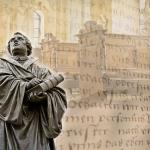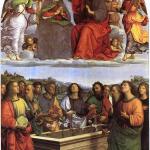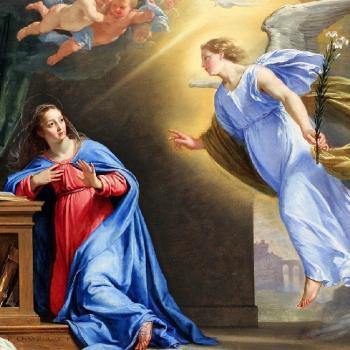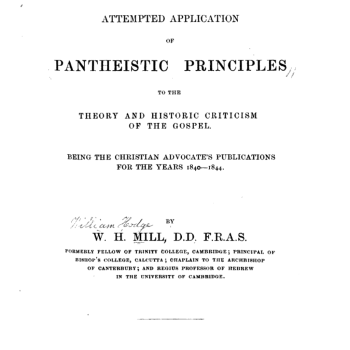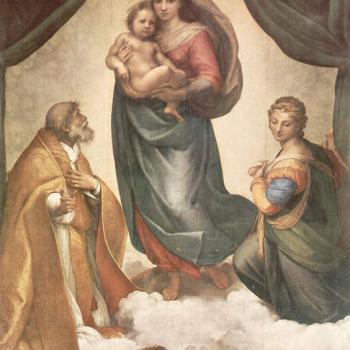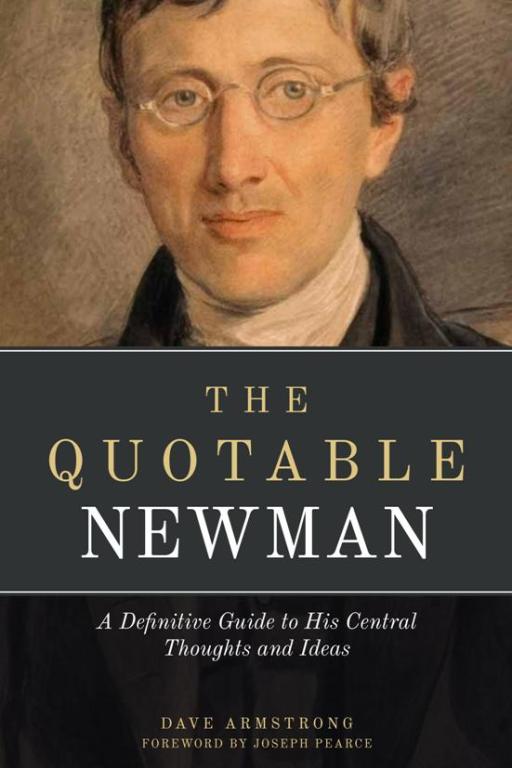
This is one of my many critiques of the book entitled, Roman but Not Catholic: What Remains at Stake 500 Years after the Reformation, by evangelical Protestant theologian Kenneth J. Collins and Anglican philosopher Jerry L. Walls (Grand Rapids, Michigan: Baker Academic, 2017).
Jerry Walls wrote about his co-author, Kenneth Collins (p. xxii):
We have heard from lots of people who have read Newman’s famous essay on doctrinal development and found his arguments compelling. I thought it might be helpful to hear from persons [i.e., Collins] who have read Newman but found his arguments deeply confused, and his conclusions badly overstated.
The present topic is one of the instances where Collins (a professor of historical theology, whereas Walls is a philosopher) is doing the writing. Ironically, when I read the section entitled “Newman’s Arian Marian Piety” from chapter 16, I found it “deeply confused” and “badly overstated.” Cardinal Newman is my theological hero, and his Essay on Development was the primary influence on my conversion to Catholicism in 1990, as I have written about in one published article and another section of my book about Catholic conversion. I ran the largest website devoted to Newman links for many years, and have edited three books of his quotations: the first published by Sophia Institute Press, and second and third volumes on my own. I’ve also written a book about development of doctrine (my favorite theological topic), and another about the Blessed Virgin Mary, and have a web page devoted to development as well (one of very few out there!). Thus, this topic is of extreme interest to me.
Collins objects to very high titles being given to Mary by the Church fathers (as Newman noted in his Essay on Development, which they critique in this section): some of which are associated with God. Thus Newman mentioned that St. Ambrose said Mary was “signified by the Pillar of the cloud.” I don’t see why this description poses any problem for the Protestant, since the cloud is not literally God. God was merely “in” the cloud (Ex 13:21; Num 12:5; 14:14; Dt 31:15; Ps 99:7) and led the Israelites “by” it (Neh 9:12).
That’s no more saying that the cloud is God, than saying that fire is God, because God appeared to Moses in the burning bush (Ex 3:4), or that the ark of the covenant was God because He had a special presence there above the mercy seat between the two carved cherubim (and, of course, Mary is described as the new ark of the covenant in Scripture). Therefore, mere creatures could be described by the same thing.
Moreover, “the angel of God” (a creature) was also said to have the same characteristic of being in this cloud that guided the Israelites (Ex 14:19). The complexities of “the angel of God / the Lord” often being described as being God Himself or having His characteristics is a fascinating and somewhat complex one, that I have written about. But as related to the present topic, it shows that describing Mary as being “signified by the Pillar of the cloud” is not problematic at all from a strictly biblical viewpoint. The angel of God (also a creature) already is so described in Holy Scripture; just as he was, by the way, with the burning bush (Ex 3:2).
But Collins objects to what they regard as excessive Marian veneration and “the entire Bible” being “sifted for any title that could possibly be applied to Mary.” Well, I just showed how “pillar of cloud” could possibly have been applied to Mary, as a concept in harmony with Scripture by various analogies which are themselves scriptural. I don’t see how that could be objectionable. If he simply doesn’t care for it or like it, in his own brand of Christian piety, that’s one thing, but to argue that it is an “unbiblical” strain of thought is quite another. He has not shown that, with regard to “pillar of cloud.”
He objects to St. Niles calling Mary “the Eastern gate through which the High Priest alone goes in and out,” but he (for some odd reason) leaves out the final part of the quotation by Newman of St. Niles [or, Nilus] (“. . . yet is ever shut”). That’s a reference to the virginity of Mary in partu (i.e., during birth; a miraculous childbirth, with Mary retaining her physical virginity). In partu virginity was accepted even by Martin Luther and many Protestants since his time, so it is hardly an exclusively Catholic belief. Marian expert Fr. Juniper Carol verifies that St. Niles wrote about Mary’s in partu virginity:
In St. Nilus’ three letters, the first and third deal with Mary’s virginity post partum, and the second with her virginity in partu; he sharply rebukes his adversaries . . . at this period we have no knowledge of a single bishop who opposed Mary’s perpetual virginity; . . .
But that aspect aside, it is hardly objectionable to call Mary a “gate” since a gate is no more God than fire or the ark or the pillar of cloud were. They are all physical substances or created things, whereas God is not. I don’t think God the Father or Jesus are called a “gate” (I might be wrong). We have Psalm 118:20: “This is the gate of the LORD; the righteous shall enter through it” (RSV). Why couldn’t we call Mary a gate, in terms of the incarnation: the human “gate” through which God the Son entered into our arena? How is this inharmonious with the Bible, let alone blasphemous, or “excessive” in any way? Where’s the [biblical and/or theological] beef? I just don’t see it.
Collins objects to Antiochus calling Mary “Morning Star” (presumably because Jesus was called this in Revelation 22:16). But Jesus is called several things that others are also called; for example, a “prophet” (which Jesus called Himself: Mt 13:57) and an “apostle” (Heb 3:1). We don’t say that prophets and apostles shouldn’t be called those things because Jesus also was; so why object to Mary being “the morning star” because Jesus was also called that? God the Father calls Jesus “my Chosen” (Lk 9:35), but He calls King David the same thing (Ps 89:3), and (as is well-known) the entire Jewish people (Is 45:4 and many passages).
He takes issue with “perhaps the most troubling accolade of all”: St. Proclus calling Mary “God’s only bridge to man.” Yes, that seems excessive to me, too. But I would note that Cardinal Newman stated immediately before this expression and after the others cited above, in summary, “These are oratorical expressions; but we use oratory on great subjects, not on small.”
In other words, “oratory” (like Marian devotional language itself) is often extravagant and hyperbolic and not always to be taken literally. Also, right after the quote, Newman writes, “and elsewhere he breaks forth, ‘Run through all creation in your thoughts, and see if there be equal to, or greater than, the Holy Virgin Mother of God.’ ” St. Proclus (whatever his arguable rhetorical excesses) plainly acknowledges that Mary is a creature, not in any way equal to God. Thus, the other statement has to be interpreted in light of that. Mary could conceivably be a “bridge” from God, just as St. Paul says essentially the same of himself:
Ephesians 3:2 assuming that you have heard of the stewardship of God’s grace that was given to me for you . . .
Mary’s certainly unique in terms of the annunciation and incarnation, and so thus can (unarguably) be regarded in this sense as a unique bridge from God to man (the Church fathers, with their idea of the “second Eve” or “new Eve,” agreed). We’d have to see more of St. Proclus’ context to see exactly what he meant by the (prima facie) seemingly excessive phrase. Protestants habitually love to pull together quotes of this sort as “self-evidently” objectionable, without delving into immediate context, the overall thought of the person saying them, or the important and relevant questions of genre and style and language.
Collins then makes a subtle (though utterly misguided) argument, in commenting on Newman’s very sophisticated analogies used throughout his Essay on Development: including this particular section. It’s far too involved to summarize, but suffice it to say that he has completely misunderstood Newman, and put things together that he did not put together. He claims that the characteristics that Arian heretics applied “to Christ,” Newman applied also to Mary: namely (citing them citing Newman):
“having an ineffable origin before all worlds,” “the Intercessor for man with God,” and “the Object of worship, the Image of the Father.” . . . “God of the Evangelical Covenant” and “Creator of the Universe.”
He claims that Cardinal Newman was arguing in his Essay on Development that these descriptions “should rightfully be applied to Mary” and that it was Newman’s desire in this section to “move” these titles “from Christ . . . to Mary . . .”
He did no such thing! This is a complete misreading of the analogies Newman was drawing. It’s the rather common polemical Protestant “debunking” of Catholic Marian language (I’ve dealt with it many times in my apologetics), without properly understanding it in the first place; and here there is an additional element of the extremely subtle and brilliant analogical reasoning of Cardinal Newman simply not being properly grasped. I urge readers to read the entire section (ch. 4, section 2, no. 8). Cardinal Newman states in it:
[T]he Nicene Council recognized the eventful principle, that, while we believe and profess any being to be made of a created nature, such a being is really no God to us, though honoured by us with whatever high titles and with whatever homage. Arius or Asterius did all but confess that Christ was the Almighty; they said much more than St. Bernard or St. Alphonso have since said of the Blessed Mary; yet they left Him a creature and were found wanting.
In other words, to simplify and summarize it, he was contending that the Arians, even in their error, illustrated that a mere creature could conceivably be called many exalted things (i.e., venerated and honored– not worshiped or adored — as Catholics venerate saints). They were blasphemously wrong about Christ, in regarding Him as a mere creature and not God. But they showed that [one they falsely regard as] a creature could be very highly honored.
The Council of Nicaea (and councils following) then elucidated the same principles in an orthodox way, applying some of them to the Blessed Virgin Mary. Note that — far from equating the Arian rhetoric about Christ with Catholic piety regarding Mary — Newman thought the Arian rhetoric was “much more than” what “St. Bernard or St. Alphonso [i.e., some of the most extravagant Marian devotees] have since said of the Blessed Mary.” In no way is he making the two things the same. Collins is dead-wrong about that.
Cardinal Newman then explains in the next section 9: almost seeming to be directly responding to Collins’ misunderstanding of what he meant in his analogical argument:
I am not stating conclusions which were drawn out in the controversy, but of premisses which were laid, broad and deep. It was then shown, it was then determined, that to exalt a creature was no recognition of its divinity.
Then he goes on to mention in section 10 that the Council of Ephesus declared Mary “the Mother of God” (which means of course, “God-bearer”: or, “mother of God the Son: Jesus”).
Collins makes the ludicrous claim that Newman thinks terms like “the Image of the Father” ought to be applied to Mary as well as Christ. Some of His titles can be applied to others (as seen above); others clearly cannot. This is one of the latter. A search of “image of the Father” on the Newman Reader website (I played a small role in setting it up), which contains all of the works of Cardinal Newman, quickly shows that he never applies this attribute in any of his voluminous writings, to Mary, and I can assure all readers, as a longtime devotee of Newman and published editor of his quotations, that he did not do so here.
Let’s take another phrase that Collins claims Newman applied to Mary: “an ineffable origin before all worlds.” This is absurd as well. No Catholic who knows anything would have ever believed, let alone sated, such a thing. Mary came into existence when she was conceived by St. Anne (i.e., through procreation, like all the rest of us), and no earlier. We’re to believe that Newman actually believed and intended to teach in his Essay on Development, the notion that Mary came into existence before the creation of the universe?
His “argument” that Newman thought Mary should also be called “God” and “Creator” is also self-refuting. It’s obvious, I think, that it is Collins who missed his meaning, rather than a scenario in which one of the most brilliant minds in the history of Christianity, has supposedly stated outrageous doctrines that no renowned Catholic thinker or authority has ever stated. Talk about “badly overstated” arguments! Collins, in his zeal to disprove Blessed John Henry Cardinal Newman, shoots himself in the foot in this particular section.
Collins cites the great Church historian Jaroslav Pelikan (Lutheran and later in life, Orthodox) in this same section (his 1996 book, Mary Through the Centuries, which is part of my library), with regard to Marian excesses. Pelikan had an infinitely higher regard for Cardinal Newman than Collins does. Thus, in his 1988 work, The Melody of Theology, in the article on Newman, he opined that the Essay on Development was “the seminal work for the thought of theologians and historians –and, above all, of historians of theology” (p. 181; my italics). This is the judgment of a scholar who produced a famous five-volume history of the development doctrine (which I also own). Dr. Pelikan goes beyond that, into almost rapturous praise:
Not only to his latter-day disciples, therefore, but to many of those who have drawn other conclusions from his insights, John Henry Newman has become the most important theological thinker of modern times. (Melody, p. 181; my italics).
I agree! My own personal opinion is that he was the greatest Catholic mind and thinker since St. Thomas Aquinas. But Collins would have readers think that such an eminent Churchman and dazzling writer as Newman (even in the estimation of a then-Lutheran scholar like Pelikan, and, if he is right, many others, too, including many non-Catholics), was foolish enough to argue that Mary should be called “God” and “Creator” and “the Image of the Father.” It’s not even remotely plausible, and it is untrue as a matter of fact.
For readers who want to delve far more deeply into this false and ludicrous accusation that Newman raised Mary virtually to demigod status, see the very in-depth discussion Jerry Walls had with Peter Sean Bradley on his Facebook page. Bradley thoroughly defends Newman’s orthodoxy, by appealing to the larger context (in the Essay on Development) of the remarks that Collins critiqued and vastly misunderstood.
***
Photo credit: my book of Newman quotations (Manchester, New Hampshire: Sophia Institute Press, 2012). The photograph is from approximately 1845: the year that Newman wrote his Essay on the Development of Christian Doctrine, which was critiqued in the section that I am replying to.
***


